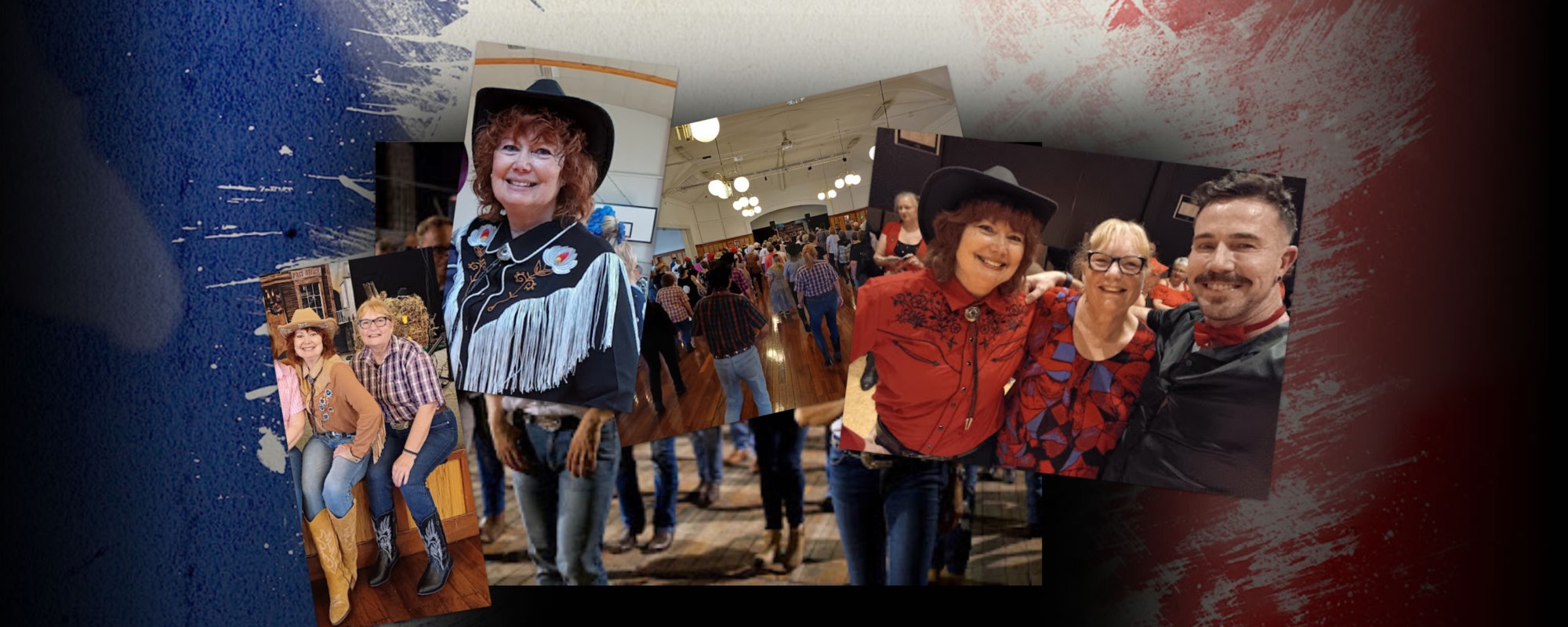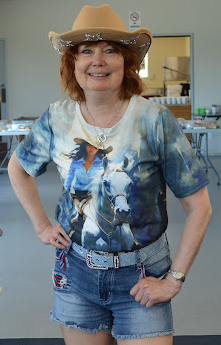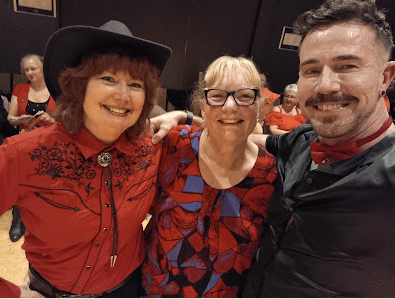
Get in LINE for fun and fitness
Original article on Frances Harrison (NZ) Blog
Click here to visit original article on Frances' blog, thank you Frances for sharing on Linedance NZ 😊My Journey into Line Dancing
When I was younger I pooh-poohed Line Dancing as something for old folks who couldn't mange other forms of dance. Now that I'm not so young I must admit to being wrong. There's currently a resurgence of this western/rodeo/cowboy style of dance where you don't need a partner. Tik Tok is presenting it to much younger and very enthusiastic generations. I'm really into it after 11 months and can see that there are so many sub-genres of line dancing that there's a style for everyone on the internet.
 What is Line Dancing?
What is Line Dancing?
A line dance is a choreographed dance in which a group of people dance along to a repeating sequence of steps while arranged in one or more lines or rows. The sequence is usually 32, 48 or 64 counts repeated during the song. Counts are beats in the music. There are also partner line dances though this doesn't seem to be very available in NZ. Kiwi guys don't seem keen on dancing, for the most part.
Line dance choreographers put in “tags” and “restarts” to make sure dances match up well with the music. A tag is a different set of moves than what you’re repeating (e.g. you may do the same 32 counts to four walls then do this different bit of choreography once then go back to the normal moves). A restart is where you start over from the beginning before finishing the normal counts (e.g. you may do the set of 32 counts 3 times facing different walls then on the 4th repeat you might do the first 16 counts of the normal moves and go back to count 1). That stuff is confusing, but a lot of the time someone will yell tag or restart so you know something weird is about to happen and you get the hang of it.
Costuming
This is a source of frustration for me. Most classes I have turned up for in NZ rarely have anyone looking other than having walked in off the street. It spoils the atmosphere for me. You wouldn't do this for other dance genres. Imagine a ballet dancer who can't be bothered changing into her gear, or a latin dancer who couldn't be bothered getting the right shoes. These days it's a small investment in minimal gear that you can later add to. I myself tend to go Cowboy/Rodeo - well remember where it comes from. I do not wear baggy track pants and sneakers. What do I like to wear? For me, this is the really fun part...
Jeans, cowboy hat (for socials), cowboy boots (ankle or better still mid-calf with a cuban heel for stomping), a fringe shirt or embroidered yokes western shirt, western belt with an ostentatious western buckle, short denim shorts, short fringe shirt, bolo western tie, western-themed T shirt/ earrings/necklace.
Some dancers buy a club T-shirt to wear. I may do that for classes this year but dressing up in my cowboy gear is what I will continue to do for socials.
Once you are serious you can inexpensively add in a boot bag, more hats, boot bling, hat bands. Yes, Temu has a lot to answer for. Amazon freight charges preclude me using them much.
Benefits
Gets you out of the house and connecting with other enthusiasts during classes and socials, maybe make a friend? You can choose to wear cowboy gear, which is a lot of fun. The really cheap hats are nothing more than toys and aren't a long term solution as they don't fit as well and don't look realistic. Quality leather cowboy boots with a cuban heel and a quality full-size wrangler-style hat will set you back a lot so they are things to save for later.
Socials
These are where dancers from an assortment of clubs all come together for a few hours or much of a weekend to learn new dances at a workshop or just dance together. The challenge here is that each club learns different dances and versions so it pays to check out the dance list ahead of time. Eventually you will automatically know most of the dances on offer. I'm still pretty new to it all. I've learned a lot and the only thing holding me back is not knowing enough of the more challenging choreographies. Last year I was lucky enough to attend workshops run by international choreographers Josh Talbot, Nigel Mooney, Simon Ward.
Health Benefits
Many folks are elderly so LD gets them out of the house and shuffling to music (country/pop). They also get to do something social. Those of us who refuse to be 'elderly' can just push on through, actually dance the dances, progress from Beginner to Improver to Intermediate (Advanced is rare), work up a sweat (necessary to get fitter). And folks, it works. I already feel fitter ad stronger after 10 months of line dancing classes and socials. Don't underestimate the power of those small repetitive movements (so long as you push yourself a bit). I can attest to improved balance and muscle tone, increased strength, a good work-out for my memory, stress reduction.
How to Get Started
- Find a convenient beginners class
- Position yourself near the front of the class so you can see.
- Don't be afraid to ask questions; line dancers are friendly and helpful
- Bring water to class and shoes/boots that have smooth soles (sneakers are no good - too grippy)
- Give yourself at least 6 weeks to see if you enjoy it because it takes time to learn
- Step sheets are available online from Copperknob https://www.copperknob.co.uk/
- YouTube have many demos and tutorials of dances you may be learning but make sure you are studying the correct music and choreography (there can be many versions)
- Copy more experienced dancers as you change walls.
Origins of Line Dancing
It is said to have originated in the US in the 1970s and was initially popular with disco music (remember Footloose?) and country music. Billy Ray Cyrus's Achy Breaky Heart really shot this dance genre into mainstream dance. These days pop, rock and country styles of music are used but look out for samba and cha-cha and even latin style with some contemporary dance tendancies.
Basic Steps for Beginners
Grapevine, jazz box, kick ball change, hitch, rocking chair, lock step, pivot turn, heel strut, chasse or shuffle, rumba box, hip bumps, waltz step, K-step, V-step, coaster, charlston, slide, fan, brush, mambo.
Find a Class or Event
Want to find a class near you? Want to see what events are coming up? Check out the links below.